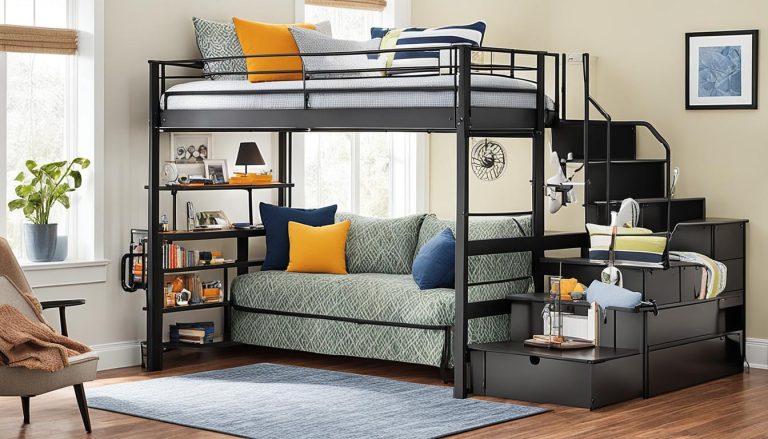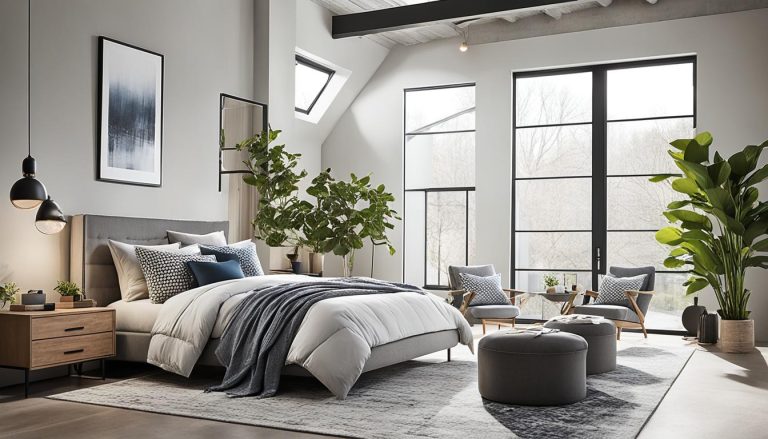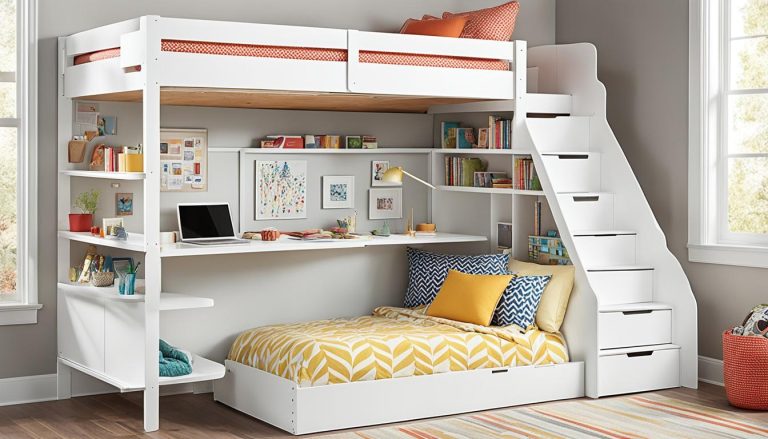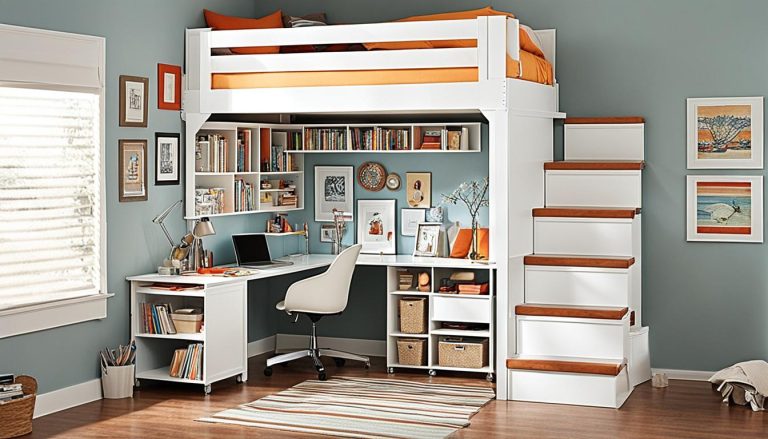The Ultimate Guide to Loft Bed Safety: Tips for Parents
houseremodelingnews.com may earn a commission if you purchase a product through one of our links
As a parent, you want your child to have a fun and safe space. Loft beds can be exciting but also bring risks. I remember when my son wanted a loft bed, his eyes shone with excitement. Yet, I worried about loft bed safety. If you’re worried too, you’re not alone.
Did you know nearly 36,000 kids visit the ER each year from bunk bed accidents? That’s a scary fact. But, with the right safety steps, you can make a cool loft bed safe for your child.
This guide is full of important tips for loft bed safety. We’ll cover how to pick the right bed and teach your kids to use it safely. You’ll learn about risks and how to avoid them, keeping your child’s room safe.
Let’s explore loft beds together. We’ll see how to use these space-saving beds safely. With the right knowledge and precautions, you can make loft bed safety a worry of the past for you and your child.
Understanding Loft Beds: What They Are and Why They’re Popular
Loft beds are a top choice for making the most of space in homes and dorms. Let’s dive into what loft beds are, their benefits, and how they stand out from bunk beds.
What is a Loft Bed?
A loft bed is a bed that sits high off the ground. This design frees up floor space below. It’s ideal for small rooms, studios, and dorms because it saves space.
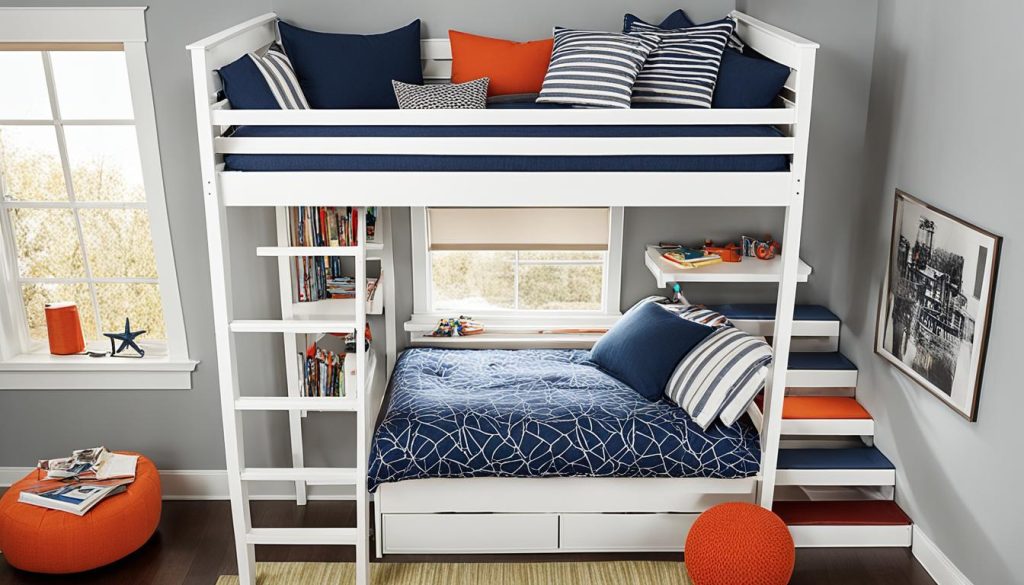
Loft Bed Benefits
Loft beds offer many advantages, making them a favorite for kids and adults alike:
- Space-saving: It clears the floor for desks, storage, or play areas
- Versatility: You can add slides or curtains for extra fun
- Multifunctional: They often come with built-in desks, shelves, or seating
- Cost-effective: Prices range from $100 to $3,000, depending on the features
Bunk Bed vs Loft Bed
Bunk beds and loft beds both use vertical space well, but they’re different. Bunk beds stack two beds, great for shared rooms. Loft beds have one raised bed, leaving space below for your own use. This makes loft beds versatile for personal areas, like a study nook or reading corner.
Loft beds turn bedtime into an adventure while giving kids their own little world to explore.
Loft beds are a smart choice for any room, whether it’s a child’s bedroom or a college dorm. With different heights and customization options, you can easily find the perfect loft bed for your space and style.
Age Recommendations for Loft Bed Use

Loft bed age recommendations are key for kids’ safety. The right time for a loft bed depends on your child’s age and maturity. For kids around 6 years old, low-height loft beds are perfect. For 8-year-olds, mid-height loft beds are better. High loft beds are ideal for tweens and teens.
Experts say kids under 6 shouldn’t sleep in the top bunk for safety reasons. Some say wait until age 9. As your child grows, check the bed’s weight limits and safety features often.
- Low-height loft beds: Suitable for 6-year-olds
- Mid-height loft beds: Ideal for 8-year-olds
- High loft beds: Best for tweens and teens
Loft bed safety for kids is about more than age. Think about your child’s coordination, rule-following, and sleep habits. Make sure the guardrails are at least 5 inches above the mattress to stop falls. The ladder should be strong and easy to climb.
“Children’s safety should always come first when choosing a loft bed. Assess your child’s readiness and follow safety guidelines to create a secure sleeping environment.”
Loft beds aren’t just for kids. Adults can use them too, but check the weight limits and follow the instructions. By focusing on loft bed safety for kids and following age guidelines, you’ll make a safe and cozy space for your child to sleep and play.
The Ultimate Guide to Loft Bed Safety
Loft beds are great for making the most of small spaces. But, they need extra safety steps. Let’s look at important safety tips and common worries.
Why Safety Guidelines Matter
It’s crucial to follow loft bed safety rules. These rules stop accidents and keep your child safe. Making sure it’s put together right, watching the weight limit, and checking it often are all important.
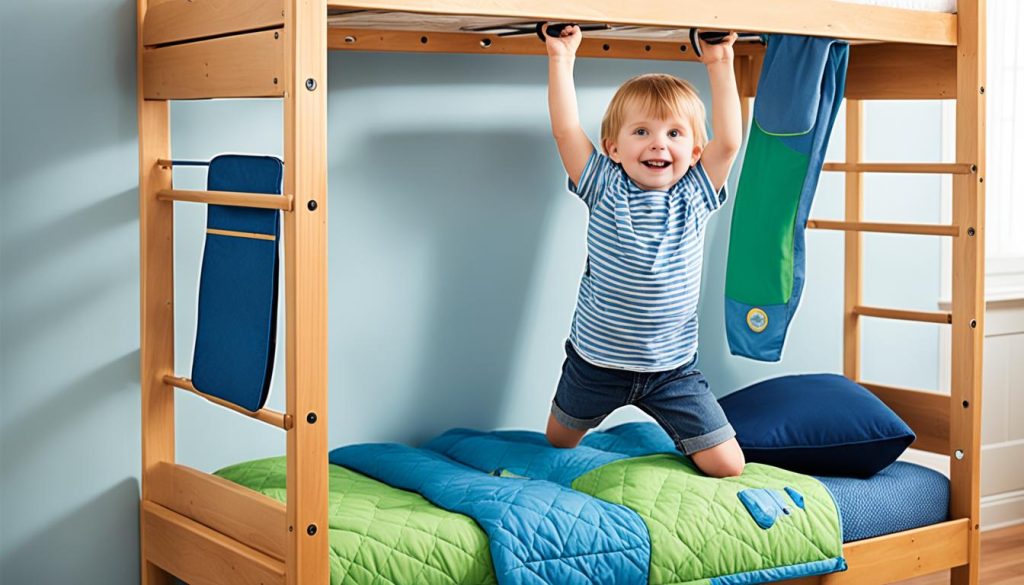
Addressing Safety Concerns
There are big worries about loft beds, like falls, getting stuck, and strangling risks. Here’s how to lessen these dangers:
- Put strong guardrails on all sides of the bed
- Make sure the mattress fits well to avoid gaps
- Keep the area around the bed free from dangers
- Use a ladder with non-slip steps for safe climbing
Teaching your kids how to safely use their loft bed is key. Tell them not to jump or play rough on the bed. Always use the ladder when getting up or down.
“Safety doesn’t happen by accident. It’s a choice we make every day.”
By knowing and doing these safety steps, you can make loft bed use safe and fun for your child. We’ll look more into safety features and tips next.
Choosing the Right Loft Bed: Safety Considerations
When picking a loft bed for your child, safety should be your top priority. Let’s explore key factors to keep in mind during your search.
Material Quality and Durability
Look for loft beds made from sturdy materials like solid wood or metal. These materials ensure long-lasting durability and stability. Check for smooth finishes to prevent splinters or scratches.
Weight Capacity and Limitations
Loft bed weight capacity is crucial for safety. Most loft beds can support up to 175 pounds. Always check the manufacturer’s specifications and choose a bed that can handle your child’s weight, plus extra for growth.
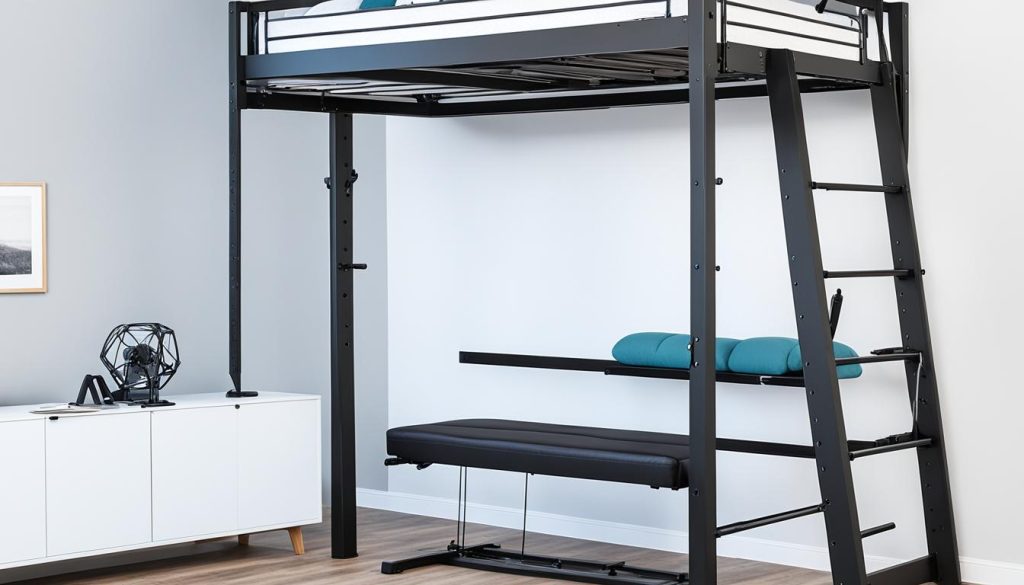
Certification and Safety Standards
Prioritize loft beds that meet strict safety standards. Look for loft bed certification from recognized bodies like the U.S. Consumer Product Safety Commission (CPSC). These certifications ensure the bed meets loft bed safety standards.
- Check for the Children’s Product Certificate (CPC)
- Ensure compliance with British Standard EN747-1:2012+A1:2015
- Verify adherence to The Bunk Beds (Entrapment Hazards) (Safety) Regulations 1987
Remember, a safe loft bed should have sturdy guardrails on all sides. The CPSC requires at least two guardrails, with one running the entire length of the bed opposite the ladder. This setup significantly reduces fall risks.
Safety is not expensive, it’s priceless. Invest in a quality loft bed that meets all safety standards for your child’s well-being.
By considering these factors, you’ll be well-equipped to choose a safe and sturdy loft bed for your child. Remember to perform regular maintenance checks to ensure ongoing safety.
Essential Safety Features of Loft Beds
Loft bed safety features are key to keeping your child safe. Guardrails are a top must-have. They should be at least 5 inches above the mattress on all sides, including if one side is against a wall. This ensures your child stays secure while sleeping.

It’s important to check the safety rails for gaps. New rules say gaps must be less than 60mm or more than 75mm. This stops kids from getting stuck or falling through. The entrance gap on the long side should be at least 300mm wide for easy getting in.
Secure ladders are also crucial. Ladder rungs must be at least 3cm wide and spaced 20cm apart. This makes climbing safe. Some loft beds have stairs instead of ladders, which is safer for young kids.
- Proper mattress support
- Smooth edges to prevent injuries
- No protruding corner posts
- Built-in storage for added stability
The mattress should be at least 10cm below the guardrails. This extra space helps prevent falls. Gaps between slats under the mattress should be no less than 7.5cm to stop entrapment.
Safety first: Always follow manufacturer guidelines and regularly check all loft bed components for wear and tear.
By focusing on these key safety features, you make a safe sleep space for your child. Regular checks and proper use keep these safety steps working well over time.
Proper Assembly and Installation of Loft Beds
Assembling a loft bed needs careful attention. It’s important for your child’s safety and the bed’s life. Let’s look at the main steps for setting up your loft bed.
Following Manufacturer Instructions
Reading the loft bed assembly instructions is key. Do this before you start. Make a list of parts and tools. Pick a quiet spot for building to avoid distractions. This reduces the chance of mistakes.
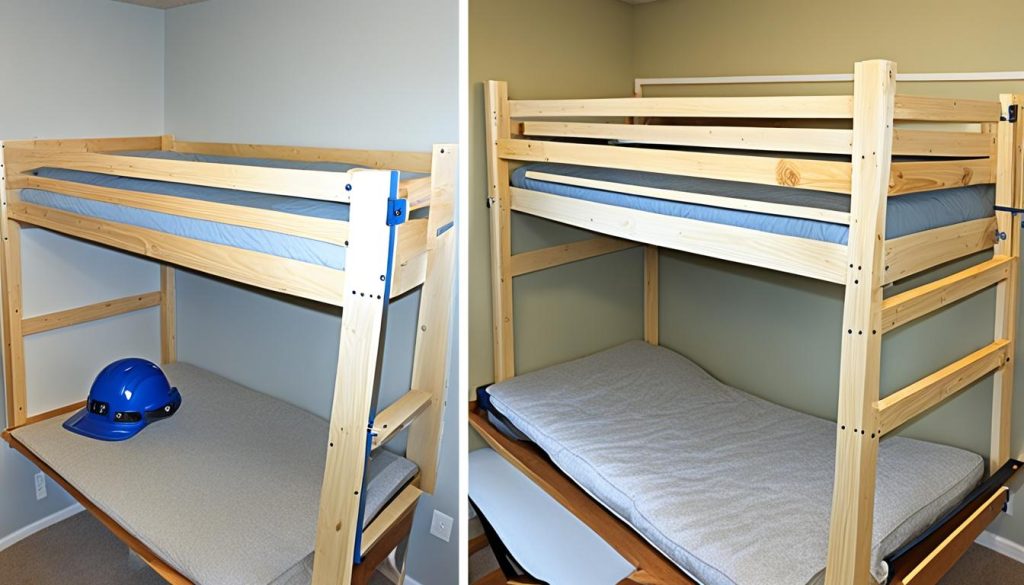
Tools and Equipment Needed
Get all the tools you need for loft bed installation ready. You’ll likely need:
- Screwdriver
- Wrench
- Allen key
- Hammer
- Level
Having these tools ready makes assembly smoother. Double-check you have everything to finish the job.
Professional Assembly vs. DIY
Think about your skills when choosing between professional and DIY loft bed assembly. If unsure, getting a pro might be best. They make sure it’s installed right and can find safety issues.
If you’re doing it yourself, take your time. Go through each step carefully. After finishing, check if the bed is stable. Use a wedge block to look for gaps. Tighten all parts before letting anyone sleep on it.
“Safety first! Always prioritize proper assembly to ensure your child’s well-being.”
Right loft bed installation is crucial for a safe sleep area. Spend the time to do it correctly, whether with professional help or on your own.
Guardrail Requirements and Specifications
Loft bed safety rails are key to keeping your child safe from falls. They must meet certain standards for the best protection. Let’s look at what makes loft bed railing specifications important.

Guardrails need to be on all sides of the top bunk, including the wall side. They should be at least 5 inches above the mattress. For example, a 14-inch guardrail with a 5-inch mattress makes a 9-inch safe height.
There should be no gaps bigger than 3.5 inches between the rails to prevent getting stuck. The opening for getting in or out should be no wider than 15 inches. Make sure there are no gaps between the guardrails and the mattress.
- Install guardrails for kids around age 2
- Use guardrails until at least age 5
- Two guardrails are essential, even if the bed is against a wall
- Perform nightly guardrail checks
When picking loft bed safety rails, choose strong, knot-free solid wood for lasting use. Some brands offer extra safety options like add-on guardrails for different types of beds.
Safety first: Always ensure your loft bed meets or exceeds safety standards to protect your child from potential accidents.
Safe Ladder and Stair Design for Loft Beds
Choosing the right climbing option for your loft bed is key for safety and comfort. Let’s look at the main points of loft bed ladder safety and stair designs. This will help you make a smart choice.
Ladder vs. Stair Options
Loft bed ladders save space and are great for older kids who are steady on their feet. Straight ladders are the most common and affordable, starting at about $1,299 for a Twin Bunk Bed with Ladder.
Loft bed stairs have wider steps, making them safer for younger kids. They also have built-in storage, so you don’t need extra furniture. Prices for these beds range from $1,569 to $3,189, based on size and features.
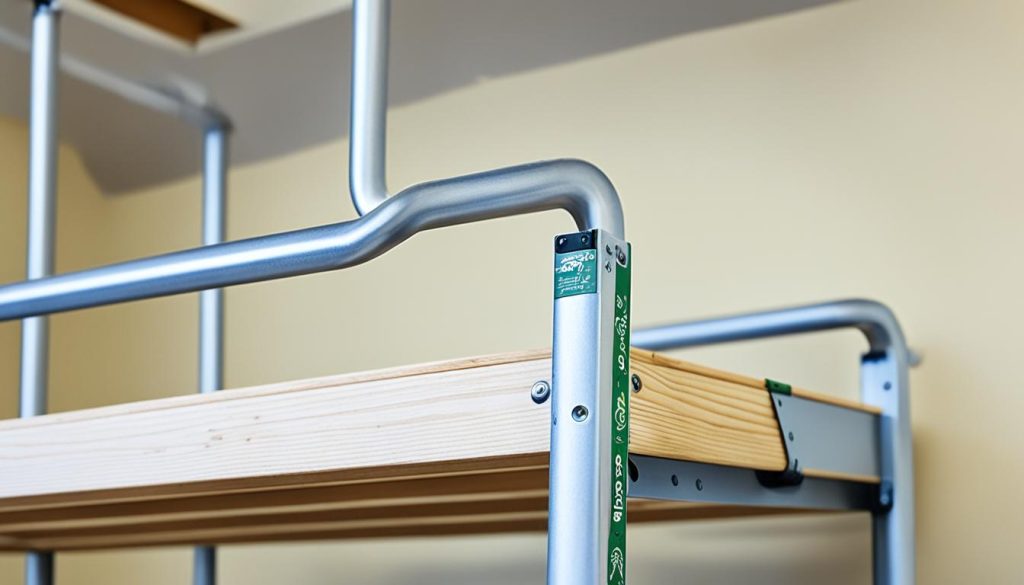
Proper Angle and Attachment
For a safe loft bed ladder, make sure it’s properly attached and angled. Ladder steps should be at least 1.18 inches wide and 7.78 inches apart. Stairs take up more space but are easier to climb. Some models have angled ladders with safety rails for a good mix of saving space and safety.
Non-slip Surfaces for Added Safety
Use non-slip surfaces on loft bed ladders for safety. Many stairs have grooved, anti-slip surfaces and sturdy banisters. For ladders, think about adding padded rungs for more comfort and safety.
“Staircases are the safest option due to their larger surface area, built-in handrails, and coverage on both sides for added protection.”
When deciding between a ladder or stairs, think about your child’s age, room size, and what they prefer. Always check and keep your loft bed’s climbing area safe.
Mattress Safety: Choosing the Right Size and Type
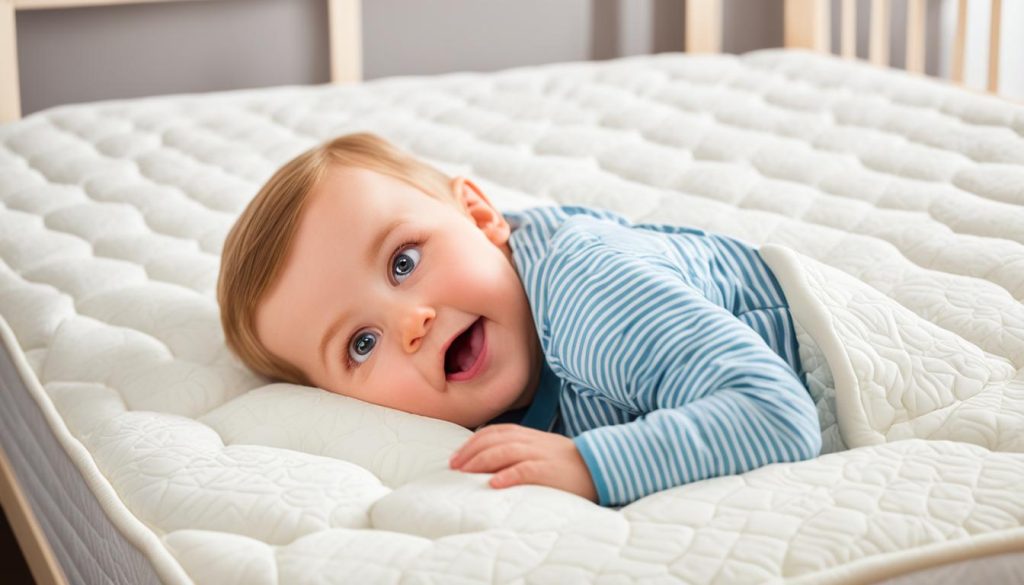
Choosing the right mattress is key for your child’s safety and comfort in a loft bed. It’s important to follow guidelines for loft bed mattresses. Let’s look at how to pick the best mattress for your child’s loft bed.
The size of the mattress is important. Twin mattresses (38″ x 75″) fit most loft beds. For taller kids, consider Twin XL (38″ x 80″). But make sure your loft bed can support a Full-size mattress (54″ x 75″) if you want extra space.
Thickness is crucial. Aim for 5-6 inches thick mattresses in loft beds. This ensures enough space between the mattress top and guardrails. Safety rules require at least 5 inches of guardrail above the mattress.
- Twin mattress: $129 for a 5-inch memory foam option
- Twin XL mattress: $139 for a 5-inch memory foam choice
- Full mattress: $179 for a 5-inch memory foam selection
Think about the firmness of the mattress too. A firm mattress prevents sagging and supports your child better. Look for mattresses with GREENGUARD Gold Certification to reduce indoor air pollution and chemical exposure risks.
Don’t forget about waterproofing. Kids under five might have accidents. Choose a mattress with a waterproof cover or add a water-resistant pad for extra protection.
“Selecting the right mattress is a balance of comfort, safety, and practicality. Take your time to find the perfect fit for your child’s loft bed.”
Regular checks are crucial. Inspect the mattress for wear and tear. Replace it when necessary to keep your child safe and comfortable. By following these guidelines, you’ll create a safe and cozy sleep space for your child.
Creating a Safe Environment Around the Loft Bed
Setting up a safe loft bed room is key for your child’s safety and comfort. The right placement of the loft bed can help avoid injuries and make sleeping cozy. Let’s look at how to make a safe and comfy space around the loft bed.
Room Layout and Placement
When placing a loft bed, keep it away from ceiling fans and light fixtures. Put the bed in a corner for extra stability. Make sure there’s at least 30 inches between the mattress and ceiling to stop head injuries. This way, your child can sit up safely without hitting their head.
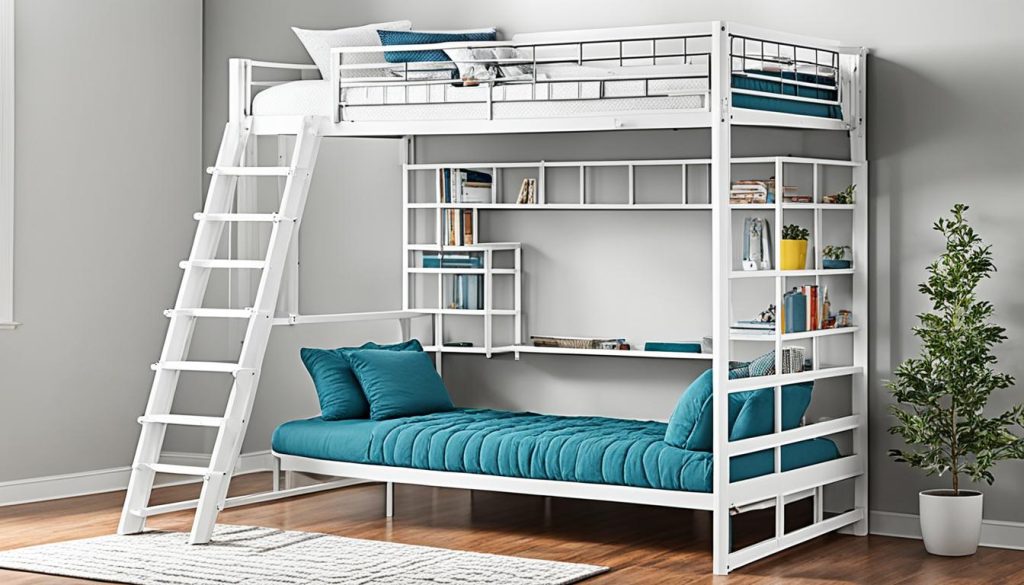
Lighting Considerations
Good lighting is essential for a safe loft bed area. Add a night light near the ladder for safe use at night. Think about putting a wall-mounted reading light to cut down on climbing. Proper lighting helps avoid falls and makes the space more useful.
Removing Hazards
Keep the area around the loft bed free from clutter. Take away toys, cords, and other things that could cause trips or falls. Make sure window blind cords are out of reach to stop strangulation risks. Keep the space under the bed tidy if your child plays there.
“A well-planned loft bed setup can reduce injuries by up to 50%,” says pediatric safety expert Dr. Sarah Johnson.
By following these tips, you’ll make a safe and cozy loft bed area for your child. Always check the setup and make changes as needed to keep it safe.
Educating Children on Loft Bed Safety Rules
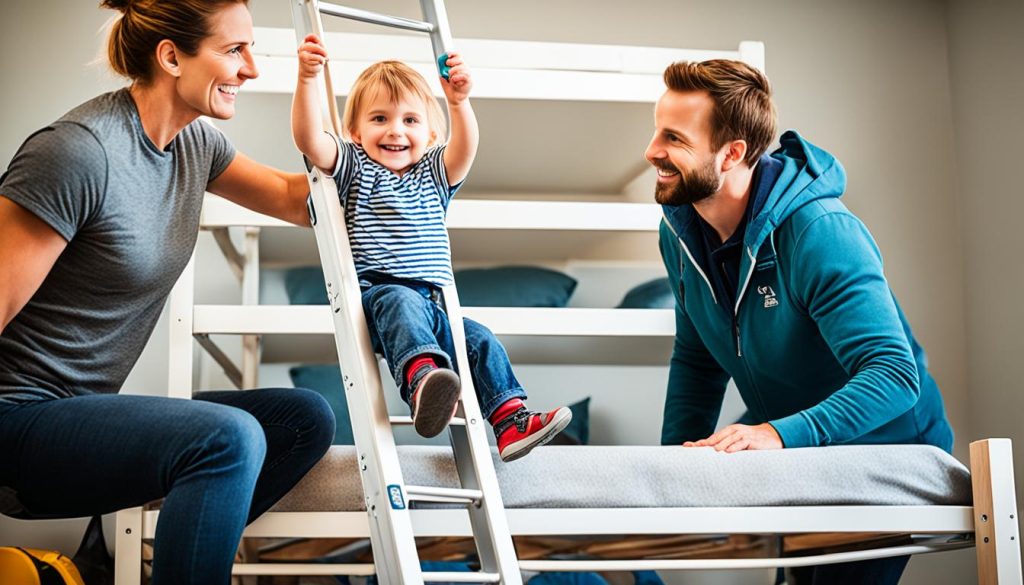
Teaching kids about loft bed safety is key for their safety. It’s important for them to know how to use their beds right. By setting clear rules, you can keep your child safe and avoid accidents.
Begin by explaining the basics of loft bed safety to your child. Tell them that only one person should be on the top bunk at a time. This is crucial, as over 35,000 kids visit the emergency room each year due to bunk bed falls.
Teach your child how to use the ladder or stairs safely. Show them how to climb up and down facing the ladder. Also, remind them not to play or jump on the bed, as it can cause serious injuries.
- Keep the area around the loft bed clear of toys and clutter
- Never hang items from the bed frame or guardrails
- Respect the weight limits of the loft bed
- Avoid rough play near or on the loft bed
Keep reminding your child of these safety rules often. Talk about them and set a good example. Make sure your child’s friends know the rules too. By focusing on loft bed safety, you can make a safe and fun space for your child to rest and play.
Regular Maintenance and Inspection of Loft Beds
Keeping your loft bed in top shape is key for safety. Regular checks can stop accidents and make your bed last longer. Let’s look at the main parts of inspecting loft beds.
Checking for Loose Bolts and Connections
Begin by checking all bolts and connections on your loft bed. Tighten any loose parts you find. This keeps the bed stable and safe. Make it a regular task to do this every month.
Inspecting for Wear and Tear
Examine guardrails, ladder, and support structures closely. Look for damage like cracks, splinters, or sharp edges. Also, check the mattress for sagging. These problems can be dangerous if ignored.

When to Replace or Upgrade
Think about upgrading your loft bed when:
- Your child outgrows the weight limit
- The bed shows significant wear
- You notice persistent structural issues
Remember, getting a new bed is worth it for your child’s safety.
Do a full loft bed check every three to six months. If your child uses the bed a lot, check it more often. Keeping up with maintenance ensures your child sleeps safely.
Accessories to Enhance Loft Bed Safety
Loft bed safety accessories are key to making your child’s sleep area safe and fun. They increase safety and add to the bed’s functionality. Let’s look at some important loft bed safety enhancements that can really help.
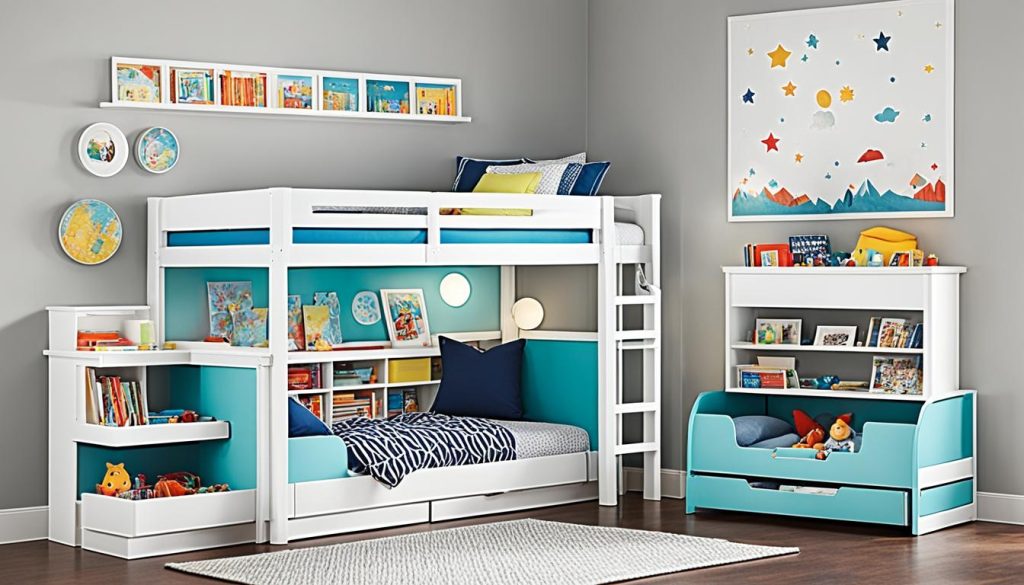
Non-slip treads are essential for ladder rungs or stair steps. They give extra grip, cutting down the chance of slipping and falling. Bed rails also add extra protection against falls, reaching at least 5 inches above the mattress to meet safety standards.
Corner protectors are a great addition to your loft bed safety items. They cover sharp edges, stopping bumps and bruises. For a fun touch, think about a slide attachment. It’s not only exciting; it’s a safer way for kids to get down from the top bunk. Slides are best for kids aged 6 and up.
- Organizers and storage solutions keep the area tidy
- Mattress retention straps prevent the mattress from moving during sleep
- Low-profile mattresses increase bed rail height for safety
When picking loft bed safety accessories, always choose products recommended by the manufacturer. This ensures they fit well and keep the bed strong. Regular checks of all attachments are key to keeping your child’s sleep area safe and fun.
Addressing Common Loft Bed Safety Concerns
Parents worry a lot about loft bed safety. They fear falls, getting stuck, and the bed breaking. To fix these issues, put up proper guardrails. Make sure the gap between the rail and mattress is 16cm to stop falls but still let kids move easily.
Starting safety with age is important. Kids under 6 shouldn’t sleep in the top bunk because it’s too risky. Teach older kids the rules: no jumping, only one person at a time, and use the ladder right.
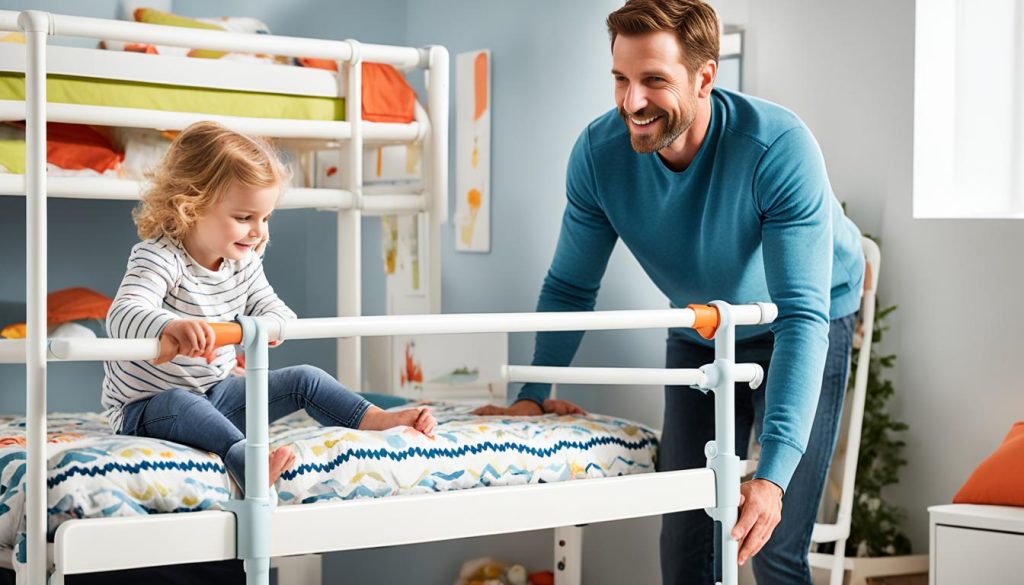
Checking your loft bed often is crucial for safety. Make sure all parts are tight for stability. Know the weight limit, usually 80-100 kilos. Keep the bed away from windows and ceiling fans to lower risks.
- Use clip-on shelves for safe storage
- Add integrated lighting for visibility
- Install handrails on ladders
- Keep the area around the bed clear
Loft beds are for sleeping, not playing. Playing on them raises the chance of accidents. By following these tips, you’ll make a safer place for your child to sleep.
Closing Thoughts
As we finish this summary on loft bed safety, it’s clear these beds can be both fun and safe for kids. Every year, over 35,000 kids visit the emergency room because of bunk bed falls. By following our safety tips, you can greatly lower the risk of accidents.
Keeping your loft bed safe is an ongoing task. Always check for loose bolts, worn parts, and make sure guardrails are in place. Remember, kids under 6 should never sleep in the top bunk, as safety experts advise. By making a safe space and teaching your kids how to use it right, you’re helping them have safe and fun years ahead.
This recap on loft bed safety highlights the importance of proper setup, sticking to weight limits, and keeping the area around the bed safe. With these steps, your loft bed can be a great addition to your child’s room. Always stay alert, put safety first, and enjoy the extra space and fun a loft bed adds to your home.


